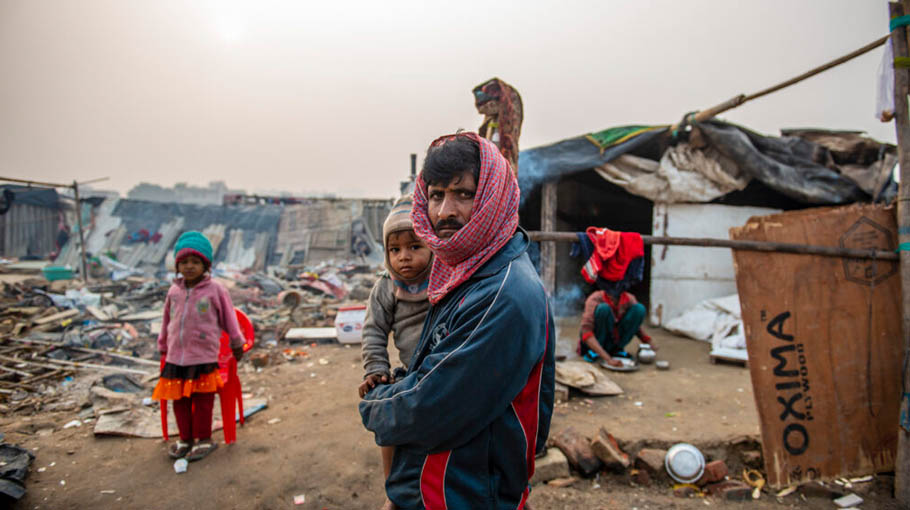Political narratives on poverty that mislead

Demonstrating poverty reduction is a mainstay of political success in India. How much progress has been made, why poverty persists, what more needs to be done and what it means to be poor in modern India are hotly debated issues.
According to the World Bank’s poverty headcount—which sets the poverty line for lower-middle-income countries at US$3.65 per day—poverty in India declined from 60.9 per cent in 2015 to 46.5 per cent in 2021. Over the same period, India’s National Institution for Transforming India (NITI-Aayog) reported that multidimensional poverty fell from 24.85 per cent to 14.96 per cent, while 2022–23 consumption expenditure data suggests a near eradication of poverty at purchasing power parity of US$1.90 per day.
If accurate, this is cause for celebration. These trends mean India is one of only a handful of countries on track to meet the United Nations Sustainable Development Goal of reducing multidimensional poverty by at least half by 2030.
But such poverty data needs careful consideration. The challenges of data collection, reliability and manipulation, mean that statistics on poverty must be treated with scrutiny.
In India, reliability is not only compromised by the politics of poverty statistics but also because the increased number of items included in the 2022–23 Consumption Expenditure Survey inflates poverty reduction when compared against the previous survey in 2011–12.
Further, progress on multidimensional poverty in India has been calculated using the results of the government’s National Family Health Surveys—without use of the latest expenditure data—leading many observers to challenge the credibility of official statistics and their associated narratives of progress.
Real progress on poverty reduction may not be as pronounced as statistical trends suggest. More difficult still is determining whether poverty alleviation has been the result of good policy and programs or of independent social and economic forces. Whatever progress has been achieved, there’s need to look beyond monetary measures of poverty to better understand what forces push people into poverty, trap them there and lift them out.
In India, structural oppression and systemic injustice have helped maintain cycles of poverty. India is the world’s fifth largest economy and is home to more billionaires than any other country bar China and the United States, but it has the lowest Human Development Index of all G20 countries. India’s poverty is not only due to lack of wealth but also a skewed distribution of wealth resulting from persistent and intersecting forms of discrimination, exclusion and exploitation.
While Hindu Higher Castes account for just 22.28 per cent of India’s population, they hold 41 per cent of total wealth and 35.3 per cent of all land. By contrast, Scheduled Castes and Scheduled Tribes—which combined represent 27 per cent of the population—hold just 11.3 per cent of assets and 11.3 of land. Under the caste system, privilege, opportunity, discrimination and disadvantage are ascribed at birth.
Regarding gender inequities, women account for just over 25 per cent of the organised labour force—a rate much lower than in neighbouring Bangladesh, Nepal or Sri Lanka.
A widely raised concern during the leadership of Prime Minister Narendra Modi has been the persecution of Muslim communities. This is accompanied by impoverishment, with Muslims being the poorest religious group in the country, owning just 8 per cent of total national assets.
For many of India’s poor, systemic injustice leads to feelings of hopelessness. This is perhaps most strikingly represented in the country’s suicide rate.
More than 170,000 suicides were reported in 2022. Nearly one-third of those individuals were daily wage earners, agricultural labourers and farmers. The 2022 suicide rate is the highest recorded since the inception of the National Crime Record Bureau’s reporting in 1967 and represents an average 468 deaths by suicide per day.
With a national election in May 2024, renewed interrogation of India’s poverty achievements and challenges is needed.
The data suggest that progress has been made on monetary poverty alleviation, though what this progress looks like remains contested. Even if World Bank poverty data is accurate, it suggests that approximately 651 million Indians continue to live below the lower middle-income poverty line and 166 million suffer multidimensional poverty. Without discounting what has been achieved, there remains much to be done.
In a country of 1.4 billion people, the persistence of poverty is an undeniably complex challenge. Despite this complexity, it is also clear that India’s enduring poverty has political origins, with the ‘overt exclusion of population segments from their basic rights’ a leading cause.
It is the deeply political nature of poverty that is perhaps most concerning, particularly with India’s upcoming election. With democracy in retreat and government control rising, the concentration of political and economic power is felt most severely by the poor.
Poverty is much more than what monetary indicators reveal. Poverty is a lack of voice and capability to lead a fulfilling life. Loss of political freedom exacerbates the poor’s inability to speak out about daily struggles to access to clean water and food, education, land and housing, employment and personal security.
Things left unsaid are things left unchanged. As the avenues for India’s poorest citizens to express themselves become fewer, so too will it become more difficult for the country to meaningfully address its enduring poverty.
Avinash Chennuri holds a Masters of Global Development from James Cook University. Kearrin Sims is Research Fellow at the Cairns Institute and Senior Lecturer in Development Studies at James Cook University.
Source: CounterPunch




